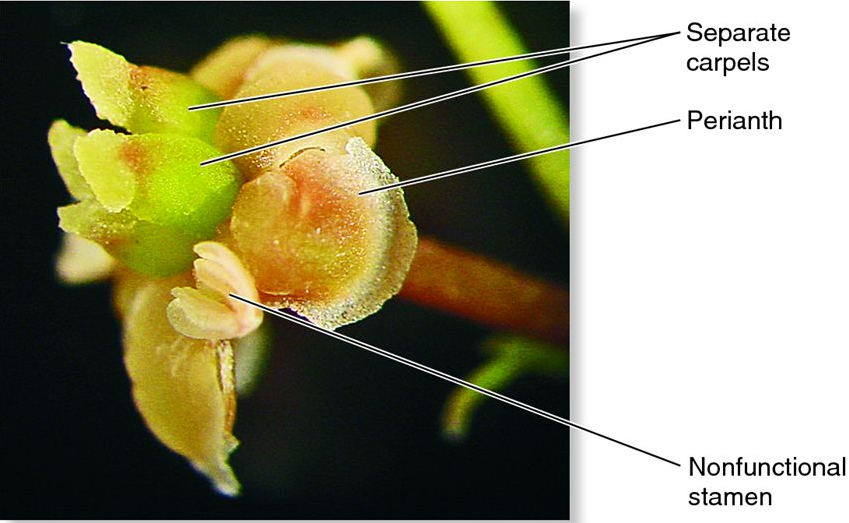Introduction
|
A. trichopoda (the only species in its entire family) is an evergreen[24] shrub or small tree (under 8m in height), endemic only to the main island of New Caledonia, a group of islands west of Australia, in the southwest Pacific. It is important to studying angiosperm evolution, because it is hypothesized to be the most basal branch of the angiosperm lineage[23] (though this is also disputed[24]).
|
Kingdom: Plantae
Class: Magnoliopsida Order: Amborellales Family: Amborellaceae Genus: Amborella Species: A. trichopoda |
Uniqueness among angiosperms
Amborella lacks vessel elements, one of the two components of xylem that virtually all other angiosperms possess[21][23], a similarity Amborella has with gymnosperms. They are also dioecious (having separate male and female flowers), a trait that only roughly 6% of angiosperms posess[25], yet is common among gymnosperms[26]. However the female flowers have may have nonfunctional stamens (pictured), and vice-versa. The fruits it bears are drupes (fleshy, pitted fruits)[24].
References
[21]http://www.cactus-art.biz/note-book/Dictionary/Dictionary_V/dictionary_vessel_member.htm
[22]http://newcaledoniaplants.com/amborella-genome-project/searching-for-clues-to-darwins-abominable-mystery-in-amborella-trichopoda/
[23]http://www.amborella.org/ (about->Amborella trichopoda)
[24]GOREMYKIN, V. V., NIKIFOROVA, S. V., BIGGS, P. J., ZHONG, B., DELANGE, P., MARTIN, W., & ... LOCKHART, P. J. (2013). The Evolutionary Root of Flowering Plants. Systematic Biology, 62(1), 50-61. doi:10.1093/sysbio/sys070
[25]Renner, S. S., & Ricklefs, R. E. (1995). Dioecy and its correlates in the flowering plants. American Journal Of Botany, 82(5), 596.
[26]http://newcaledoniaplants.com/plant-catalog/amborella
[27]http://www.bio.miami.edu/dana/226/226F09_21.html
[22]http://newcaledoniaplants.com/amborella-genome-project/searching-for-clues-to-darwins-abominable-mystery-in-amborella-trichopoda/
[23]http://www.amborella.org/ (about->Amborella trichopoda)
[24]GOREMYKIN, V. V., NIKIFOROVA, S. V., BIGGS, P. J., ZHONG, B., DELANGE, P., MARTIN, W., & ... LOCKHART, P. J. (2013). The Evolutionary Root of Flowering Plants. Systematic Biology, 62(1), 50-61. doi:10.1093/sysbio/sys070
[25]Renner, S. S., & Ricklefs, R. E. (1995). Dioecy and its correlates in the flowering plants. American Journal Of Botany, 82(5), 596.
[26]http://newcaledoniaplants.com/plant-catalog/amborella
[27]http://www.bio.miami.edu/dana/226/226F09_21.html



